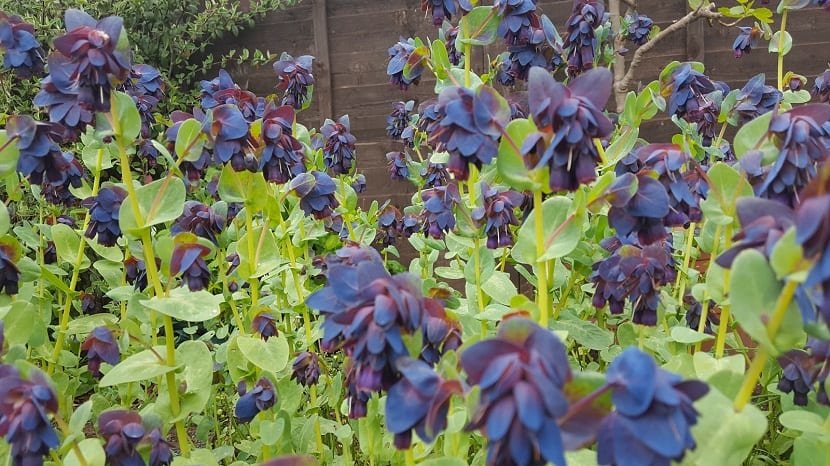
The Cerinthe major, too known as Ceriflor or Palomera, is a herbaceous plant native to open meadows and grassy plains in the Mediterranean basin, especially in southern Italy and Greece. The name Cerinthe comes from the Greek keros for the wax and anthos for the flower, since at one time it was thought that bees obtained wax for their hives from flowers. This species is an unusual member of the borage family (Boraginaceae), as it does not have hairy foliage like most members of that family.
Cerinthe major characteristics

This particular flower has been grown in gardens since the Middle Ages. The plants are not particularly dazzling from a distance, although the flowers are best appreciated up close, as the color is quite striking.
Variety "Purpurascens" it is the most commonly available type and its coloration is the strongest of the species.
This perennial type plant, has beautiful foliage and colorful bracts that last much longer than the small flowers.The rounded leaves that wrap around the stem are partially outlined, somewhat fleshy, smooth, not hairy and pale green to blue in color and arise in whorls throughout of branched stems.
Something very curious is that the leaves turn bluer as the night temperatures drop.
Plants vary considerably in size and shape Depending on the conditions under which they grow, such as full sun and rich soils, they may grow tall enough to require replanting and keeping them upright.In drier, less fertile soils or in light shade, plants tend to be more compact, reaching only about 45 to 60 cm in height.
All the hanging tubular flowers, are born in clusters of two or three, surrounded by large almost heart-shaped bracts, from early spring to October. The species varies greatly in color, with flowers ranging from cream or pale yellow to lavender or purple.
The Cerinthe major plant will attract bees and hummingbirds, in addition will add interesting colors and texturesespecially in the fall.
Growing and caring for Cerinthe major
This it is an easy plant to grow and the scale of care is low to moderate. This plant will even flourish in rich soils with little to no maintenance, in full sun or partial shade.
Potted plants require more water than plants found in soil, since they produces a better flower display when the plant is kept moist.
Sowing the seed begins indoors, 4-6 weeks before the last frost or outdoors in the spring, after the danger of the frost. If you start indoors, very large seeds should be planted individually in small pots.
Soak the seeds overnight before planting, this will help the seedlings to come out of the hard shell. You can harvest the seeds in the fall and store them in sachets until early spring.

Sow directly into the ground and cover the seed with approximately its own width of soil or compost and lastly water gently. Provide light after germination occurs, by placing it in a sunny window or under grow lights.
Once you have an established plant, self-seeding ensures a supply of ready plants every year. Outdoor plants will tend to overseed on their own.
In more temperate zones, remove the mother plant in winter and lightly cover the seeds.
When you have the Cerinthe major plant planted in pots, use a diluted plant food once a month.
Plagues and diseases
Generally this plant is free of pests and diseases, slugs perhaps. In this case, sprinkle diatomaceous earth or iron phosphate on the soil around the plant, not on it and the slugs will end up not wanting to walk around them.
HELP ! MY TEN YEAR OLD FRAMBOYAN IS DRYING IN MONTERREY, WHAT CAN THE CAUSE (S) BE?
Thanks for your reply.
Hello Francisco.
How often do you water them? Have you checked if they have any plagues?
Living where you live is important to water frequently. It may also be that they lack compost.
A greeting.